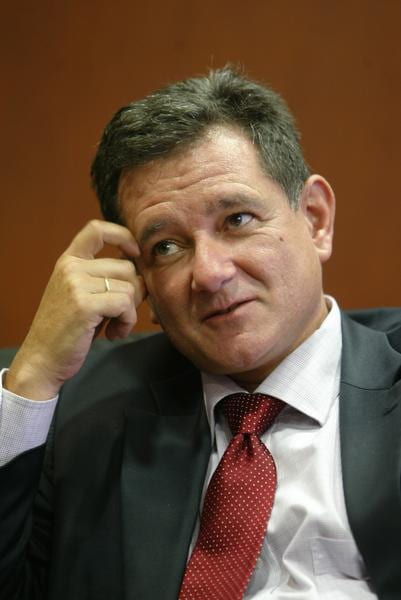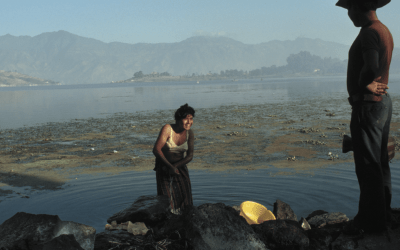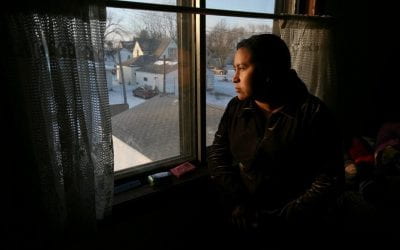The International Commission Against Impunity in Guatemala
Undoing the Legacy of Violence and Corruption
On May 10, 2009 a prominent Guatemalan attorney, Rodrigo Rosenberg, was gunned down in broad daylight while riding his bicycle down a busy, tree-lined boulevard in a wealthy residential district of Guatemala City. But this wasn’t just another killing in a homicide-plagued country. On May 11, 2009, Guatemalan television aired a pre-recorded video in which Rosenberg declared, “If you are viewing this video, it is because I have been assassinated by President Álvaro Colom.” Rosenberg went on to accuse close associates of the President, including the President’s wife, Sandra Torres de Colom, of involvement in his murder and in the earlier murder of two of his clients, prominent businessman Khalil Musa and his daughter Marjorie, purportedly over fears of revelations of corrupt narco-money laundering at the highest government levels in the semi-state bank Banrural.
The nation polarized immediately, with mass demonstrations in the capital for and against President Colom and his wife. The anti-Colom demonstrators, calling for his resignation, were mostly urban, educated professionals and university students, who had spontaneously organized through the social networking systems of Facebook, YouTube, and Twitter. Pro-Colom supporters were primarily rural people, bused in from the countryside, where potential presidential candidate Sandra Torres de Colom’s programs of Social Cohesion and My Family Progresses have been lavishing huge amounts of the federal budget on rural aid programs.
It was not until January 12, 2010, that one man stepped forward to the microphone to cut the Gordian knot of the case. He was the head of the United Nations International Comission against Impunity in Guatemala, Carlos Castresana, Spanish judge and professor of international jurisprudence. With a plethora of investigative proof, Castresana astonished a habitually incredulous nation by showing how Rosenberg had planned his own killing.
The case brought the United Nation’s Commission against Impunity (CICIG in its Spanish acronym) to the attention of the entire country. In December of 2006, the Guatemalan government had signed an agreement with the Secretary General of the United Nations to allow the formation of this special commission. The task requested of the Commission was to investigate what in Guatemala are called “parallel powers,” clandestine criminal groups with tentacles into the security forces and the judicial system of the country that became linked to the counterinsurgent army intelligence during the armed conflict. These criminal groups had for years influenced the judicial system. The Commission’s job was not only to bust these “parallel powers,” but also to crack their influence within the judicial system. Its mandate also included suggesting changes in existing laws or drafting new ones that might help eradicate the rampant criminality in the country. The Commission was unusual because it was obliged to work through the Attorney General’s staff in any prosecutorial case. As The Journal of International Criminal Justice from Oxford University points out, the Commission’s prosecutorial independence was limited by its partnership with a judicial system that it was mandated to reform, but on the other hand it was embedded in the system it needed to reform. As Castresana said in a recent interview with this writer, however, “None of the institutions here is completely corrupt. So it’s possible to find people in the police, in the prosecutor’s office, and in the judicial system who are ready to be converted into our partners.”
The average Guatemalan on the street was not feeling the benefits. The only thing that the average citizen knew was that every day his or her life was ever more fatally precarious. Since the signing of the December 1996 Peace Accords, ending 36 years of internecine warfare between leftist guerrillas and the Guatemalan army, Guatemala has been descending into a maelstrom of civilian violence far surpassing the years of war.
The sociologist and one-time government peace negotiator, Hector Rosada, observed in the press, “The peace is more violent than the war. The peace process never prepared us for the country we are now living in.”
Luis Linares of ASIES (Association of Investigation and Social Studies) put it this way: “We are living in a psychosis. The citizen leaves home in the morning and doesn’t know if he will come home alive. This is a cost that we assume every day, but it is difficult to quantify.”
Nevertheless, some data do quantify this cost. From the year 2000 to 2009, the homicide numbers have risen from 2,904 per year to 6,451, with only 230 or 3.58% prosecutions.
Guatemalan journalist Cristina Boni-llo, citing the United Nations Program for Development, has measured the cost of violence in this way, “Although it is difficult to quantify the cost of the violence in the economy of the country, it has been estimated that in 2006 alone it had reached 7.3% of the Gross Domestic Product (GDP), double the amount assigned to the Ministries of Agriculture, Health, and Education all together.”
Violence has also taken a tremendous toll on commerce. According to a World Economic Forum study, Guatemala has dropped down 11 places owing to the effect of the violence on commercial interests. The Foundation for Guatemalan Development (FUNDESA) has pointed out that crime, violence, and extortions have placed the nation at number 69 among 125 nations evaluated. The indicator of the level of costs for businesses to protect themselves from crime, violence, and extortion places Guatemala almost at the bottom, at 124. The level of confidence of businesses in the police places Guatemala at number 118.
Most of the violence is carried out by and between gangs, but as the Interior Minister Carlos Menocal has said, “The gangs are the armed arm of the clandestine groups.” They are sub-contracted to carry out the hits.
COCAINE AND DERIVATIVE CRACK
What fuels the gangs and their violence and enriches the clandestine groups are cocaine and its derivative crack. Guatemala, neighbor to Mexico, is the ideal transshipment point of cocaine from South America. Drug-war experts say that 90% of the cocaine that reaches the United States comes through the Central American Corridor, of which Guatemala is an integral part. And these experts say that the toll-fee for passing through Guatemala in part is also paid in cocaine, which filters down to the gangs.
But the Commission Against Impunity isn’t in Guatemala to clean up street crime. It seeks to eradicate impunity in governmental institutions and in clandestine parallel groups dedicated to organized crime. Castresana has indicated to the press, “The government structures have been maintained on a base of clandestine structures. Structures that are infiltrated by criminal groups.”
President Álvaro Colom’s government has had five different Ministers of the Interior, a department that controls the police. Two of them are charged with crimes, one is still a fugitive from justice. Since 1997, there have been 17 different police chiefs. The last two fired in the Colom administration were accused of seizing cocaine shipments for resale. Of the last five, four have been accused of various crimes. Police sub-directors have mutually accused one another of running death squads within the police. Numerous other police officials have been found running criminal mafias within the police. Norma Cruz, Director of the Foundation of Survivors, put it in a historical perspective, “Our past still weighs heavily on us. In the war the police were used to eliminate the enemy of the state, to kidnap, to torture, and to kill with impunity. This will not change overnight.”
TARGETING THE COFRADÍA
One of the important clandestine groups that the Commission is targeting was identified by the Washington Office on Latin America (WOLA) in its report Hidden Powers in Guatemala as La Cofradía (fraternity). La Cofradía was a group of former and active military intelligence officers, who in Guatemala’s climate of impunity, turned their cold-war counterinsurgency skills into criminal riches. This group first came to light in 1996, when the administration of President Álvaro Arzú broke a contraband ring within the customs agency later dubbed the Moreno network, after its purported head Alfredo Moreno. When the investigators began going through Moreno’s computer and photos in his house, they found links to many former military intelligence officers such as General Francisco Ortega Menaldo, Colonel Jacobo Salán Sánchez and Major Napoleón Rojas Méndez. Also found in the photos was the president-to-be Alfonso Portillo, arm in arm with Ortega Menaldo at a barbecue. Later it would be reported that Alfonso Portillo was a paid political advisor to the Cofradía.
FORMER PRESIDENT PORTILLO ARRESTED ON CORRUPTION CHARGES
One of CICIG’s great successes was aiding local law enforcement in the arrest of former President Portillo as he was trying to flee to Belize. The former president is charged with embezzling $2.5 million from a donation from Taiwan and $5.5 million in a transfer from the Ministry of Defense, aided and abetted by his heads of security, Colonel Jacobo Salán Sánchez and Major Napoleón Rojas Méndez. Rojas has been apprehended, while Salán Sánchez remains a fugitive. Portillo is also charged in the Federal Court for the Southern District of New York with money laundering of his ill-got gains. There is a U.S. extradition order against him for money laundering, which has been approved by the Guatemalan courts The key to the case against Portillo was a former Portillo-appointed head of the state National Mortgage Credit bank (CHN), Armando Llort Quinteño. Llort had sought witness protection in New York and confessed to participating in the embezzlement scheme. He sang for all to hear in the court, and it was heard in Guatemala as well. Llort claimed that the Cofradía and General Ortega Menaldo were behind the whole embezzlement scheme and that Salán and Rojas actually carried out the plan. In 2000 the National Security Archive in Washington presented declassified United States intelligence documents that confirmed the existence of the Cofradía. In 2002 the State Department revoked the visas of these military officers, who in the past had worked closely with the CIA and U.S. Defense Intelligence.
Castresana summed it up in a press statement, “What before was counterinsurgency now is organized crime.” The arrest tally so far is ex-President Portillo, Llort in New York, ex-Finance Minister Maza, former Defense Minister Eduardo Arévalo Llacs, head of the Joint Chiefs of Staff of the Army Enrique Ríos Sosa, son of one-time military dictator, Efraín Ríos Montt, and the former intelligence officer Major Napoleón Rojas. Colonel Jacobo Salán Sánchez is still a fugitive. Five other army officers from the Defense Ministry were arrested along with Rios-Sosa for the theft of $55 million from the ministry. This situation never could have taken place before the CICIG came to Guatemala.
Yet the alleged head of La Cofradía, General Ortega Menaldo, still walks free. In an interview with this writer, Castresana commented with a wry smile, “Each case has its own time. The case is open. We have to gather the appropriate evidence to make a case. We don’t speak more about it for obvious reasons.”
But Castresana points out that the Cofradía is not the only clandestine mafia. “Now there are many groups, not just one. There has been an evolution. It has shot up everywhere and multiplied like a contagion. Our analysis suggests that the violent crimes of today are the offspring of the violence of the past.” Some of these new groups moving in, like the Zetas, are Mexican drug traffickers. The drug traffickers are taking and holding territory all over rural Guatemala. It appears that they may be making alliances with local mayors and their communities.
JUDICIAL REFORM
CICIG has proposed changes in the law to accelerate the judicial process, but Congress, mired in a corrupt battle for spoils, has been slow to pass the necessary legislation; only four of fifteen suggested changes have been passed. The suggested law against illicit enrichment of government officials has been tied up in Congress since November 2008. Also still pending is the law for confiscation of property obtained through illegal means. So is the law to modify congressional impunity from legal charges that states 2/3 of the Congress must vote against a member to send him or her to trial. Other proposed changes concern search and arrest warrants and a change in mandatory time limits for holding arrested persons before they can be charged before a judge. Castresana has implored Congress to pass a law to limit the use of frivolous legal injunctions in courts that delay legal proceedings. In addition, he has raised the issue of constitutional reform.
But Castresana’s biggest challenge has come from the process of choosing the Attorney General. The framers of the 1985 Constitution intended to depoliticize the office by having the rectors of the various universities, along with the president of the national lawyers guild and a member of its tribunal of honor, come up with a list of suitable candidates from which the President could choose. This has only served to politize the elections of the university rectors, who appoint those deans. The large electoral campaigns for rector are costly and are financed now from obscure sources in order to get those votes for the candidates not only for Attorney General but also for the Supreme Court and the Constitutional Court, where the same system prevails.
This process didn’t turn out the way the framers intended. Instead, the process has allowed obscure interests to influence the choice and thus influence the courts and the Attorney General’s office.
CICIG played the role of ombudsman in the selection of the Attorney General, an office to which the organization is tied by the need for a national prosecutorial arm. Investigating the backgrounds of the six candidates chosen by the nominating committee, it found that only two of them had a clean record. Castresana informed the President and then went public with the information. Agreeing with Castresana, the Constitutional Court ordered the selection committee to reopen the search, examining closely the records of the nominees. Nevertheless, the selection committee just sent back the same list of the six, and the President chose one of the candidates with a tarnished record. Castresana resigned in protest, stating that he was not getting sufficient cooperation from the executive and legislative branches to help achieve the rule of law in Guatemala. The Constitutional Court annulled the selection and ordered that a new selection committee be formed. Publicly embarrassed, the President begrudgingly accepted the court’s decision and dismissed his new Attorney General after fifteen days. A new selection committee was recently formed.
Castresana had said earlier, “At times I feel tempted to just throw in the towel, but the truth is that this kind of a mission has to come without a towel.” But President Colom’s choice of a known tarnished candidate for Attorney General was the last straw for Castresana. It was like having that towel thrown right in his face. He lamented: “The patient won’t take his medicine, and a sick man who won’t take his medicine often ends up dying.”
A NEW CICIG COMMISSIONER
The UN Secretary General has appointed a new Commissioner for CICIG, the Attorney General of Costa Rica, Francisco Dall’Anese, known for having investigated and tried two former presidents for corruption and for his tough stand against drug traffickers. He is slated to assume leadership on August 1, with a year and a few months before CICIG’s mandate expires. It could be renewed by the Guatemalan government.
U.S. Ambassador Stephan MacFarland, a strong supporter of CICIG, worried in an interview, “A year and a few months is not whole lot of time to advance enough so that success against impunity is guaranteed….but ultimately it depends not on the imposition from outside but an acceptance by the Guatemalans.”
Fall 2010 | Winter 2011, Volume X, Number 1
Paul Goepfert is a former correspondent for The Baltimore Sun and The Chicago Tribune from 1982 until 1989 in Managua, Nicaragua. He has been a resident of Central America for eighteen years.
Related Articles
Guatemala: Editor’s Letter
The diminutive indigenous woman in her bright embroidered blouse waited proudly for her grandson to receive his engineering degree. His mother, also dressed in a traditional flowery blouse—a huipil, took photos with a top-of-the-line digital camera.
Making of the Modern: An Architectural Photoessay by Peter Giesemann
Making of the Modern An Architectural Photoessay by Peter Giesemann Fall 2010 | Winter 2011, Volume X, Number 1Related Articles
Increasing the Visibility of Guatemalan Immigrants
Guatemalans have been migrating to the United States in large numbers since the late 1970s, but were not highly visible to the U.S. public as Guatemalans. That changed on May 12, 2008, when agents of Immigration and Customs Enforcement (ICE) launched the largest single-site workplace raid against undocumented immigrant workers up to that time. As helicopters circled overhead, ICE agents rounded up and arrested …




